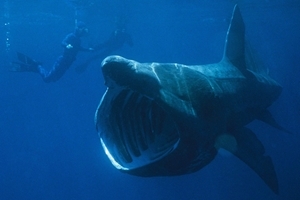Basking shark
 Many of you may be heading for the coast this August, so keep an eye open for the world’s second largest fish (the whale shark is the largest), especially if you are heading to the western side of the UK, as basking sharks (Cetorhinus maximus) favour this coastline.
Many of you may be heading for the coast this August, so keep an eye open for the world’s second largest fish (the whale shark is the largest), especially if you are heading to the western side of the UK, as basking sharks (Cetorhinus maximus) favour this coastline.
In the summer months, as the seas around the UK warm, plankton numbers rapidly grow, attracting these massive creatures to come to the surface to feed on this rich harvest. They are one of only three species of shark that feed on plankton.
As you might imagine, such a huge shark needs to eat an awful lot of tiny plankton to keep it going, so they are equipped with a two-metre-wide mouth, which can take on an Olympic swimming pool’s worth of water every couple of hours while feeding. It takes half a ton of plankton to fill a fully grown basking shark’s stomach!
Reaching lengths of up to 12m, basking sharks can weigh up to 7 tonnes and live for 50 years as far as we know. I say “as far as we know” because, despite their size, surprisingly little is known about the life history of basking sharks, partly because of the difficulty of conducting field research on an animal that spends most of its life out of sight, deep underwater.
Recent research has, however, begun to throw some light on this. Satellite tags were placed on basking sharks from the waters around Coll, Tiree and Hyskeir during summer months, and have already shown that many individuals show a high degree of site fidelity, returning to the same waters the following summer.
During the autumn, most sharks were tracked migrating southwards to the Bay of Biscay off Portugal, while three individuals travelled over 3,000km to Madeira and the Canary Islands. Particularly between March and April, seven of the tagged sharks were recorded at depths of greater than 1,000m!
So, we are beginning to understand a little more about these wonderful gentle giants, but there is still much more to discover, such as where exactly they breed, which still remains a mystery.
If you go for a swim in the sea this summer and see an enormous dark shape beneath you, just hope it is a gentle basking shark passing by. Although the really enormous sharks of past eras have all but disappeared due to hunting, it is perhaps worth noting that the largest accurately measured specimen was trapped in a herring net in the Bay of Fundy, Canada, in 1851. Its total length was 12.27 metres (40.3ft) and it weighed an estimated 19 tons.
Peter Thompson
Advisory
Read more from Peter Thompson at his blog.

Download Peter Thompson's essential 26-page book, featuring beautiful photography and detailed profiles of Britain's wildlife
Download FREE >